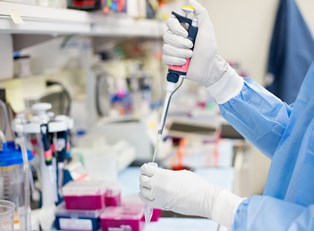DNA paternity testing is a form of genetics research that can quite accurately identify the father of a child. The demand for this sort of testing is so great that companies now offer take-home kits as well as in-office testing. However, it should be noted that in the United States, results from self-testing at home are inadmissible in custody hearings or other legal procedures.
While the testing itself is quite complex and requires extensive training, the mechanism by which DNA paternity tests function is actually fairly simple, and grasping the concept requires only a small knowledge of genetics. This overview will provide you with a basic understanding of DNA paternity testing—including how and why it works and what types of tests are available.
Why does DNA paternity testing work?
DNA paternity testing works because of the specific way that parents transfer genes to their children. Each person, with the exception of identical twins, has a unique DNA makeup with two copies of each gene. When conceived, a child receives one set of genes from the mother and another set from the father. About 99% of the DNA we inherit is identical to everyone else’s, so it’s the small but unique 1% of genetic material that is the focus in paternity testing. When done properly, researchers are able to use these tests in order to detect similarities between DNA samples and establish paternity, since a child inherits genetic material from his or her father.
How does DNA paternity testing work?
DNA paternity testing relies heavily on probability. By comparing the unique sections of DNA (sometimes referred to as “markers”), researchers are able to discern the likelihood of a particular man being the father of a child. A person’s entire genetic makeup is too large and complicated to be studied in its entirety, so DNA testers typically only look at between six and thirteen markers in a sample. However, even with this relatively small amount of information, most paternity tests offer results that can be up to 99% accurate—the more markers two DNA samples share in common, the more likely that the man is indeed the father.
What types of DNA paternity testing are available?
Currently it is possible to test for paternity both before and after a child is born, although testing after birth is much more common, since it is a less invasive procedure. It normally involves taking an oral swab from the child, mother, and any potential fathers. Contrary to popular belief, oral swabs do not collect saliva, which contains no genetic material. Instead, swabs collect loose skin cells, which do contain genetic material, from the inside of the mouth. First, the samples from the mother and child are compared to establish what genetic markers were inherited maternally. Afterwards, the DNA from the potential father is compared to the child’s, and if there are enough matches between the two, paternity can be confirmed.
When testing prenatally, a sample for the child must be obtained from either the placenta or amniotic sac. Collecting DNA from both of these areas can be dangerous, and some women may miscarry as a result of the procedure. After samples are collected, testing is typically very similar to testing after birth. It’s also possible to obtain a DNA sample for the child by taking a blood sample from the mother—since fetal blood is present in her bloodstream as well—but this method has not become popular yet, and there are only three companies that offer this sort of testing in the United States.



